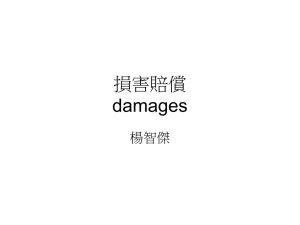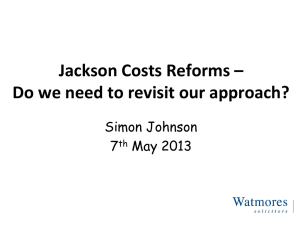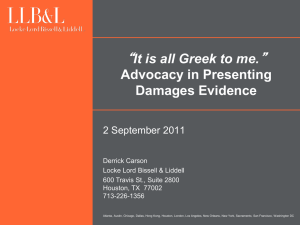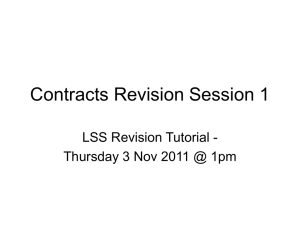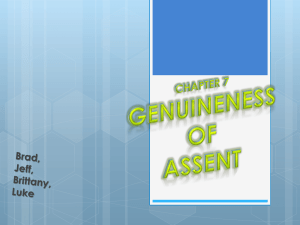Benchmarking
advertisement
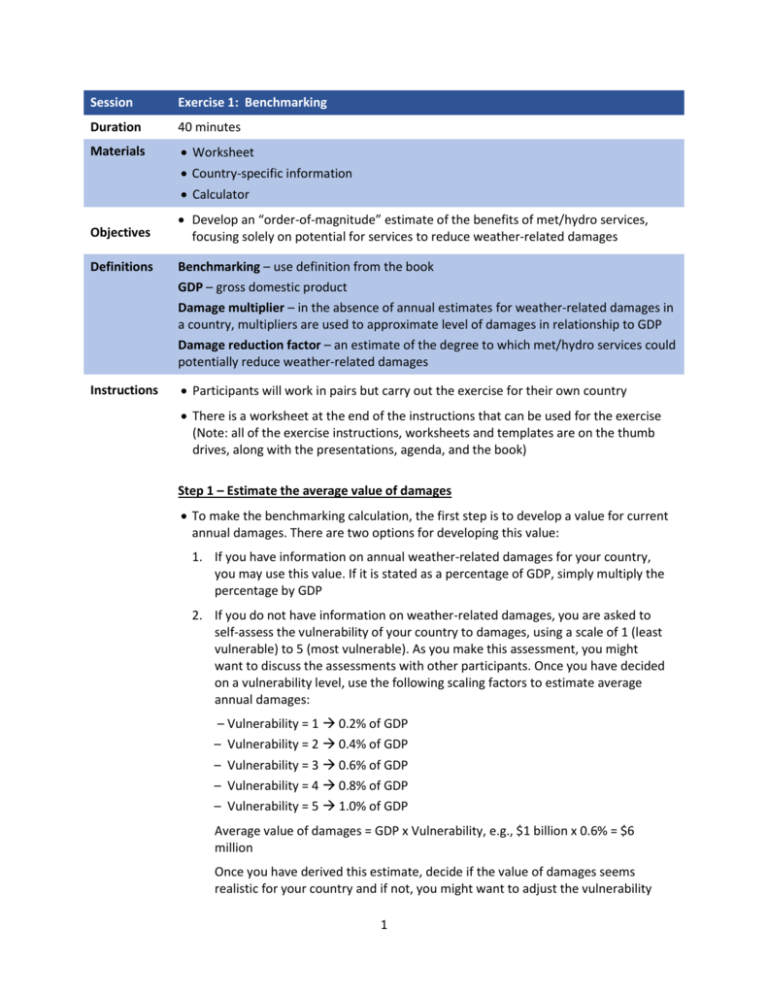
Session Exercise 1: Benchmarking Duration 40 minutes Materials Worksheet Country-specific information Calculator Objectives Develop an “order-of-magnitude” estimate of the benefits of met/hydro services, focusing solely on potential for services to reduce weather-related damages Definitions Benchmarking – use definition from the book GDP – gross domestic product Damage multiplier – in the absence of annual estimates for weather-related damages in a country, multipliers are used to approximate level of damages in relationship to GDP Damage reduction factor – an estimate of the degree to which met/hydro services could potentially reduce weather-related damages Instructions Participants will work in pairs but carry out the exercise for their own country There is a worksheet at the end of the instructions that can be used for the exercise (Note: all of the exercise instructions, worksheets and templates are on the thumb drives, along with the presentations, agenda, and the book) Step 1 – Estimate the average value of damages To make the benchmarking calculation, the first step is to develop a value for current annual damages. There are two options for developing this value: 1. If you have information on annual weather-related damages for your country, you may use this value. If it is stated as a percentage of GDP, simply multiply the percentage by GDP 2. If you do not have information on weather-related damages, you are asked to self-assess the vulnerability of your country to damages, using a scale of 1 (least vulnerable) to 5 (most vulnerable). As you make this assessment, you might want to discuss the assessments with other participants. Once you have decided on a vulnerability level, use the following scaling factors to estimate average annual damages: – Vulnerability = 1 0.2% of GDP – Vulnerability = 2 0.4% of GDP – Vulnerability = 3 0.6% of GDP – Vulnerability = 4 0.8% of GDP – Vulnerability = 5 1.0% of GDP Average value of damages = GDP x Vulnerability, e.g., $1 billion x 0.6% = $6 million Once you have derived this estimate, decide if the value of damages seems realistic for your country and if not, you might want to adjust the vulnerability 1 factor up or down. Step 2 – Assign damage reduction factor The benchmarking exercise can be carried out in one of two ways: 1) you can think about how much average damages could be reduced as a result of additional investments in met/hydro services; or 2) you can think about how much average damages might increase if met/hydro services were not provided – in this case you will be selecting a damage increase factor. The World Bank uses damage reduction factors of 20% to 60%. The choice of damage factors should consider the current quality and coverage of met/hydro services and the nature of damages. For example, if damages are mainly focused on infrastructure and buildings as opposed to loss of human life and livestock, the potential to reduce damages might be rather low. Also, if early warning systems are not available, the potential for reductions might be greater. Select a damage reduction/increase factor within the World Bank range – if you would prefer to use a factor outside of the range please explain on your worksheet why you selected a small or large factor. Step 3 – Estimate potential benefits of met/hydro services This calculation will result in one of two estimates: 1. If you decided to consider improvements in existing services, the measure you estimate is: Potential benefits = Average damages x damage reduction factor 2. If you decided to consider how damages would increase in the absence of met/hydro services, the measure you estimate is: Potential damages avoided = Average damage x damage increase factor Step 4 – Estimate costs to achieve potential benefits Depending on the type of calculation you made in Step 3, you will likely use one of the following approaches for Step 4: 1. For potential benefits for an improvement in met/hydro services, you may use a discrete amount for an investment or a percentage of current cost of met/hydro services 2. For potential damages avoided, you would use current level of funding for met/hydro services Step 5 – Compare benefits and costs Benefits and costs can be compared in one of two way: 1) Net benefits is the difference between benefits and costs; and 2) Benefit/cost ratio is the ratio of benefits divided by costs. For an investment to be attractive (on its own merits and/or in comparison to other public expenditures, net benefits should be greater than zero and/or the benefit/cost ratio should be greater than 1. 2 1. Net Benefits = Benefits (from Step 3) – Costs (from Step 4) 2. Benefit/cost ratio = Benefits (from Step 3) ÷ Costs (from Step 4) Extra credit In your concept note (later exercise), you might want to discuss the sectors of the economy that would benefit the most from investments in met/hydro services, drawing on the information you developed on the composition of GDP and your knowledge of vulnerability to damages of each sector. 3 Exercise 1: Benchmarking (Worksheet) Name(s): _______________________________________________________________ Country: _______________________________________________________________ Date: ____________________ Step 1: Estimate the average annual value of damages Direct route: Annual GDP: ____________________ USD Average annual value of weather-related damages: ______ % GDP Average annual value of weather-related damages: ____________________ USD OR Indirect route: Annual GDP: ____________________ USD Self-assessed vulnerability of country to weather-related damages (1-5): ______ Estimated average annual value of weather-related damages: ______ % GDP (1 = 0.2%, etc.) Estimated average annual value of weather-related damages: ____________________ USD Note: adjust damage values (% and USD) above if they seem unrealistic after calculating estimate Step 2: Assign damage reduction OR damage increase factor Damage reduction factor: ______ % OR Damage increase factor: ______ % Please provide your reasoning for choosing this factor, commenting on the current quality and coverage of met/hydro services, as well as the nature of damages incurred. If you selected a factor outside the World Bank range of 20-60%, please justify. 4 _____________________________________________________________________________________ _____________________________________________________________________________________ _____________________________________________________________________________________ _____________________________________________________________________________________ _____________________________________________________________________________________ _____________________________________________________________________________________ Step 3: Estimate potential benefits of met/hydro services If you choose a damage reduction factor: Potential benefits (average damages x damage reduction factor): ____________________ USD OR If you choose a damage increase factor: Potential damages avoided (average damages x damage increase factor): ________________ USD Step 4: Estimate costs to achieve potential benefits OR damages avoided If you chose “potential benefits” in Step 3 above: Estimated costs (amount for investment or percentage of current cost of met/hydro services): ____________________ USD OR If you chose “potential damages avoided” in Step 3 above: Estimated costs (current level of funding for met/hydro services): ____________________ USD Step 5: Compare benefits and costs Net benefits (benefits from Step 3 — costs from Step 4): ____________________ USD Benefit/cost ratio (benefits from Step 3 ÷ costs from Step 4): _______ Extra Credit In your concept note (later exercise), you might want to discuss the sectors of the economy that would benefit the most from investments in met/hydro services, drawing on the information you developed on the composition of GDP and your knowledge of vulnerability to damages of each sector. 5
